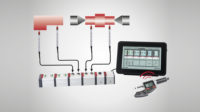Test & Inspection
Just a Twist: Not Too Much, Not Too Little Turns Out Right
Here are a handful of example quality control processes that focus on the measurement of torque, with emphasis on sectors where testing is highly regulated, FDA 21CFR Part 11 being a prime consideration.

All Images Source: courtesy of Mecmesin, a PPTGroup company
Physical testing plays a pivotal role in the journey of a product from its conception, through manufacture, and to its final destination where it interacts with the consumer … or the patient. Quality checking is a crucial step that occurs at various stages, spanning from initial design to production, guaranteeing quality of performance and quality of build. The nature of this testing varies for each business, contingent upon factors such as the product’s intended use and industry regulations. Essentially, testing assesses the functionality by subjecting the product to specific loads and measuring its response. These loads could be forces or torques applied to push/pull or twist the product respectively. The precise loading is achieved through the design of fixturing accessories that interact with the test specimen and control the applied load correctly. Torque testing raises unique challenges, and here we highlight varied examples in sectors where health and safety are paramount.
Types of torque
Torque is the application of a load—a force—at a distance from a rotational axis, causing a twisting motion. As consumers, we often find ourselves twisting, turning, and unscrewing numerous objects as our day ‘unwinds.’ Whether it’s twisting door handles, turning car steering wheels or unscrewing bottle tops, there exists a multitude of mass-produced items that necessitate the application of torque for operation. ‘Openability’ is an increasingly relevant term as an ageing population finds it more challenging to open packaging as it becomes less dexterous. This can conflict with the need to ensure packaging stays unopened until the end user gets their hands on it.
The medical devices and pharmaceuticals sectors operate within stringent regulatory frameworks, prioritizing compliance and rigorous auditing procedures. Safety test standards are of utmost importance, ultimately controlling whether a product (or its packaging) is licensed for use. The involvement of torque in these types of products often focuses on seal integrity—it shouldn’t open in use, but should be easy and reliable to connect, or exhibit application and release torque values in a pre-determined range.

Medical all-around solution
A manufacturer of glass syringes with compression-fit Luer connectors implements quality control testing of the connector by measurement of the torque required to rotate the polycarbonate fitting to ensure it cannot come away under normal use. These syringes are of various sizes, so a range of dedicated custom fixtures hold the glass, and a star-shaped mandrel to grip the Luer fitting enables all variants to be tested. Since the torques involved are light, the universal mandrel is inserted in a stirrup which allows it to also move vertically as the fitting turns on its thread, to avoid influencing the vital torque measurement.
A precise injection of quality

In products that require direct human interaction, the torques that are required to operate twisting mechanisms can be small. In the field of medical devices, on occasion, the individual needing to operate the product to self-administer their own drugs may be old or infirm. Precision measurement of light torque values requires investment in test equipment to optimize precise axial alignment and to measure loads down to low values. For medical devices used in hospital environments, the healthcare professional requires the operation to be easy, consistent, and reliable. In this example, the syringe needle cap should twist off with ease yet still remain intact under all other conditions. Test standards stipulate a torque range within which the measured test values are considered acceptable.
Round up to cap it all

The ubiquitous plastic (polymer) mineral water bottle cap is a prime example of an everyday item that an end user may encounter; applying counterclockwise torque to break a tamper-evidence mechanism and release the closure from the bottle finish (threaded section). This mass manufacturing environment often utilizes manually operated torque checking on random samples to keep production parameters in range. Innovative, or regulation-driven design changes are evaluated with motorized, software-controlled torque measurement systems. This equipment is able to apply a constant rotational speed, turn to exact angles, and to reverse direction as needed in the test’s operational procedure. The importance of gripping a bottle closure consistently in every test necessitates the use of custom-fit cap mandrels, to grip and turn the cap without measurement-compromising deformation. In the case of a polymer bottle, the lower fixturing method also needs to grip securely without deformation and may require a different solution for testing glass or metal containers.
The software collects the torque data and is vital in determining the characteristics at strategic points in the opening process:
- Initial slip of the cap as it starts to move, overcoming the friction of the bottle material
- Peak as the tamper evident (TE) ring bridges are overcome
- Continuing steady-state torque as the cap is unscrewed to complete release
Conclusion
We have seen a handful of example quality control processes that focus on the measurement of torque, with emphasis on sectors where testing is highly regulated, FDA 21CFR Part 11 being a prime consideration. Testing hardware selected to grip these types of products is able to implement the twisting action precisely, and paired with capable software provides a complete solution. With such control within reach, it makes sense for manufacturers in all industries to take a closer look, or brand reputation may take a turn for the worse.
Looking for a reprint of this article?
From high-res PDFs to custom plaques, order your copy today!





